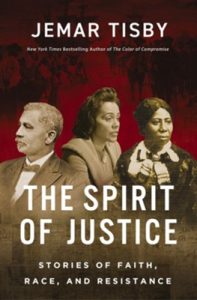 Summary: Stories of resistance.
Summary: Stories of resistance.
This is a natural next book for Jemar Tisby. His first book was a survey of the ways that the church in the US has been complicit with racism. The second book was a response to the question, “What should we do now” that he kept getting from people who read the first book. And this third book is designed as inspiration for continuing to work for justice.
I am fairly well-read in civil rights history and there were both well-known figures and people I did not know here. The balance between the known and the unknown (or lesser known) was good. You can’t ignore major figures like Martin Luther King Jr, but in some ways, those figures are less inspiring because they have become “saints” of the movement. The lesser-known figures I think are more inspiring because they worked toward justice without becoming well-known.
That isn’t to say those lesser-known people are less important. Part of what Tisby is doing is bringing balance to the story. There is a whole chapter on women of the civil rights movement, not because they were completely unknown but because the sexism of the time impacted how we tell stories today. And many behind-the-scenes figures were essential to the organizational and movement-building work that allowed the well-known people to become well-known.
Immediately after finishing The Spirit of Justice, I picked up a new biography of John Lewis. Lewis was well known by his death, but part of what the biography illustrated was the long arc of that fame. Lewis spoke at the 1963 March on Washington, but that was after having led the Nashville student movement and then SNCC. But when he left SNCC leadership, he was only 26. He had several completely separate careers after that. He headed the Voter Education Project for 7 years, and under his leadership VEP registered an estimated 4 million people. He also spent several years working for the federal government in the Carter administration, six years on the Atlanta city council, and 34 years in Congress.
I bring up John Lewis because as well known as he is today, had he done any one of the many things (Freedom Rider, Nashville sit-in movement, SNCC leadership, SCLS board member, voting rights advocate, Selma Marcher, and a main mover of the remembrance of the Selma March, he may not be well-known. But whether he was well-known or not, his contributions mattered.
And that is why The Spirit of Justice matters. This is a book of inspiration to know those who have done the work to bring about the progress toward justice that has been accomplished thus far. While not every person is primarily known as a Christian, the reality is that justice, especially around racial issues in the US has been historically rooted in the Black Church. Most of the figures in The Spirit of Justice were themselves shaped by and a member of the Black Church. There were a lot of complaints about the Color of Compromise not telling the stories of how the church worked toward justice. Those complaints missed the point of the book in highlighting how the church was compromised. The Spirit of Justice now highlights the stories of those who worked for justice. And I think contextually important, it records how often those stories of justice were opposed by other members of the church in the United States.
The Spirit of Justice: True Stories of Faith, Race, and Resistance by Jemar Tisby Purchase Links: Hardcover, Kindle Edition, Audible.com Audiobook